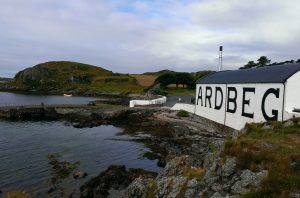Standing on the shore at Ardbeg distillery, it’s possible to catch a glimpse of Northern Ireland on a clear day. While Islay may give that wonderful peaceful impression of sitting on the edge of the world, its whiskies lie at the very centre of Scotland’s national drink.
Islay produces some of the most famous single malts on the planet. Yet many of the island’s whiskies also provide the smoky backbone to some of Scotland’s best-selling blended Scotches.
That combination of distinctive individuality and blending ability means that the island’s importance belies its small size. It may only measure 24km in length and be home to around 3,000 people, yet Islay boasts nine distilleries. So getting to know the island’s whiskies is a rewarding journey.
Where is Islay?
Lying off the west coast of Scotland, Islay is the most southerly island in the Inner Hebrides. To its north sits Jura, a more mountainous island, while to its east lies the Kintyre peninsula – beloved of Sir Paul McCartney and Wings – and to its south Northern Ireland beckons.
For many visitors, their journey will start on board the CalMac ferries that sail daily from Kennacraig on Kintyre or weekly from Oban. Yet flying to Islay on one of Loganair’s small planes from Edinburgh and Glasgow – or Hebridean Air’s scenic routes from Colonsay and Oban – can be a magical experience on a sunny day.
As well as its whisky, Islay is famous for its wildlife, especially the thousands of geese that visit each winter, and rarities such as chough and corncrake. The island also has a rich history, stretching back 10,000 years, and vibrant food and traditional music scenes.
How do you pronounce ‘Islay’?
The ‘y’ at the end of ‘Islay’ is silent, so the island’s name is pronounced ‘eye-la’. By way of a public service announcement, please never say ‘eye-lay’.
In his seminal 2003 whisky travelogue Raw Spirit, novelist Iain Banks blamed the mispronunciation of ‘eye-la’ as ‘eye-lay’ on a 1980s advert on the London Underground for the duty-free shops at Heathrow airport, proclaiming Laphroaig offered ‘Islay for less outlay’ with a false rhyme. Picky bartenders will bristle when guests pronounce the ‘y’.
In a similar vein, the names of Islay’s two main bays – Loch Gruinart and Loch Indaal – are pronounced with a soft ‘ch’ at the back of the throat, not the harsh ‘ck sound found in a door or canal lock. People from Islay are known as ‘Ileachs’ – that’s a bit trickier to pronounce, but visitors will win brownie points for effort with ‘eee-luch’.

What are the most famous distilleries on Islay?
Islay’s nine distilleries fall into three clusters. The north is home to Ardnahoe, Bunnahabhain and Caol Ila; while Bowmore, Bruichladdich and Kilchoman sit roughly at its centre. To the south lie Ardbeg, Lagavulin and Laphroaig.
Distilleries such as Ardbeg, Bowmore and Laphroaig have global reputations supported by generations of fans. Yet the past 20 years have also seen the rise of boutique distilleries.
Bruichladdich is perhaps the most famous. Revived in 2000 when former wine merchant Mark Reynier led a consortium to buy the mothballed site from Whyte & Mackay for £6 million, it created The Botanist gin brand to generate cash while its whisky aged, before the distillery was sold to Rémy Cointreau in 2012 for £58m. Following in its footsteps, single-farm distillery Kilchoman was founded in 2005 and family-owned Ardnahoe began distilling in 2018.
What does Islay whisky taste like?
‘Smoky’ is the word that first springs to mind for Islay’s whiskies, especially for those three on the island’s south coast. That flavour comes from the peat that’s used to dry the malted barley, which sprouts so that its starch can be turned into sugar for fermentation and distillation.
Peat is brown and stringy and looks a bit like dense turf – in the past, it was burned instead of coal or wood for heat and light, especially on Scotland’s islands and west coast. Local peated whiskies formed the core of Scotland’s west coast blends, such as Johnnie Walker.
Not all Islay’s whiskies are peated though. Bunnahabhain’s signature style is unpeated, and Bruichladdich was traditionally unpeated too, although it’s also now home to the peated Octomore and Port Charlotte variants.
Which Islay whiskies should I try?
Peter Ranscombe recommends four classic Islay bottles to try

Ardbeg Ten Years Old Islay Single Malt Scotch Whisky
Don’t let its light colour fool you: Ardbeg always packs a punch. Smoke, tar and TCP aromas only hint at the much deeper roast meat, charcoal, and brighter green apple flavours on the palate. There’s pleasing complexity beyond the peat. Alcohol 46%
Bruichladdich Islay Barley 2013 Single Malt Scotch Whisky
An almost-naked nose, letting the cereal notes from the barley grown on seven farms on the island shine through. Those cereal notes dominate initially on the palate before fading to reveal deeper lemon rind, barley sugar and tangy soy sauce notes. Alc 50%
Bunnahabhain 12 Year Old Islay Single Malt Scotch Whisky
A fruity nose full of red apple, peach and runny honey. This leads into brown sugar, thicker heather honey and salted caramel on the palate, with only the tiniest hint of woodsmoke. A light texture, yet no compromise on the intense flavours. Alc 46.3%
Laphroaig 10 Year Old Islay Single Malt Scotch Whisky
A warmer waft of smoke on the nose in contrast to the medicinal scent of near neighbour Ardbeg. Sweeter spun sugar flavours dance in between deeper seams of charcoal, like the top of a well-fired bread roll from Aberdeen. Alc 40%


